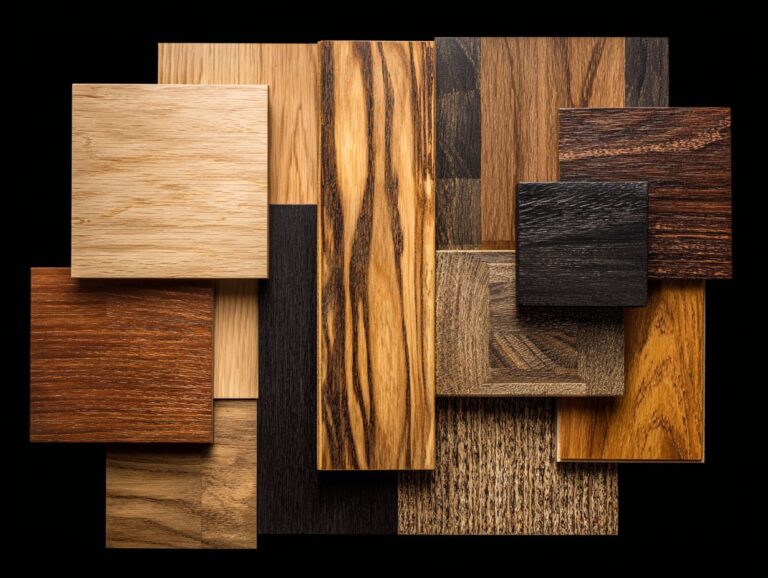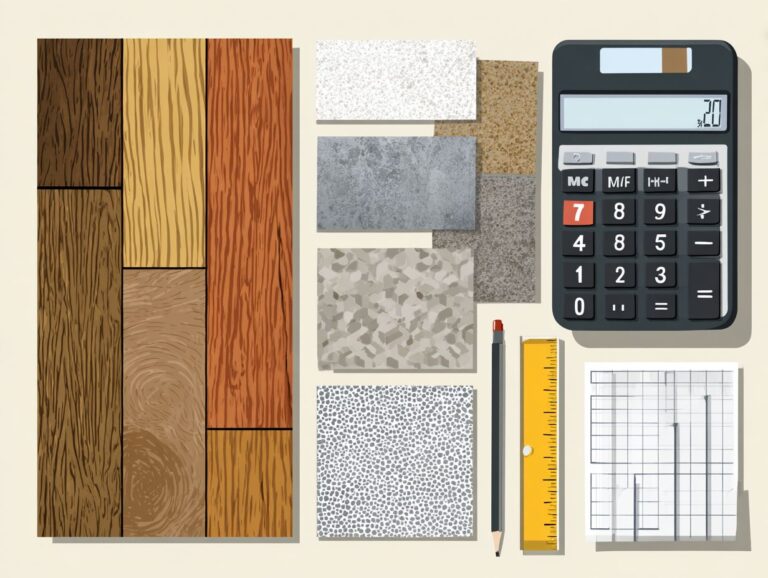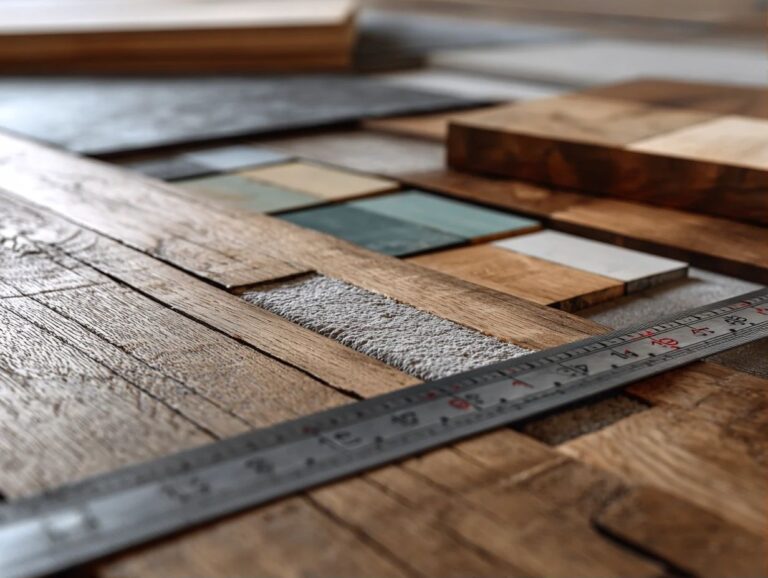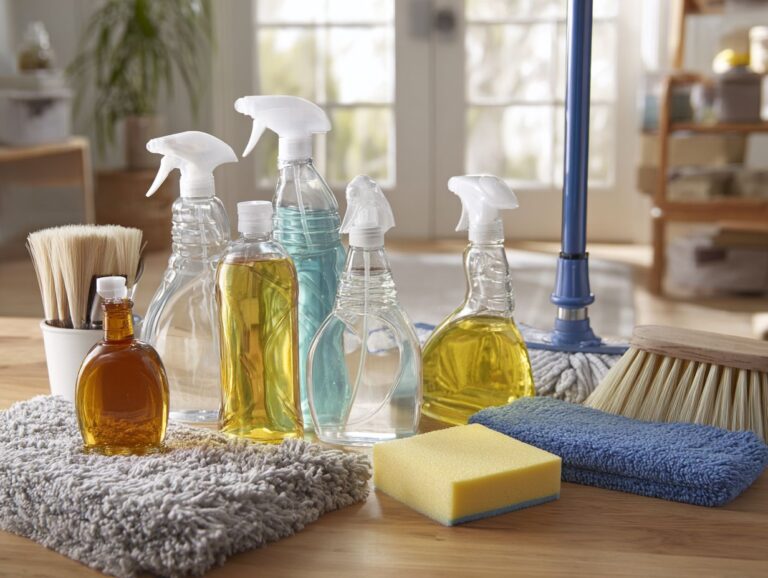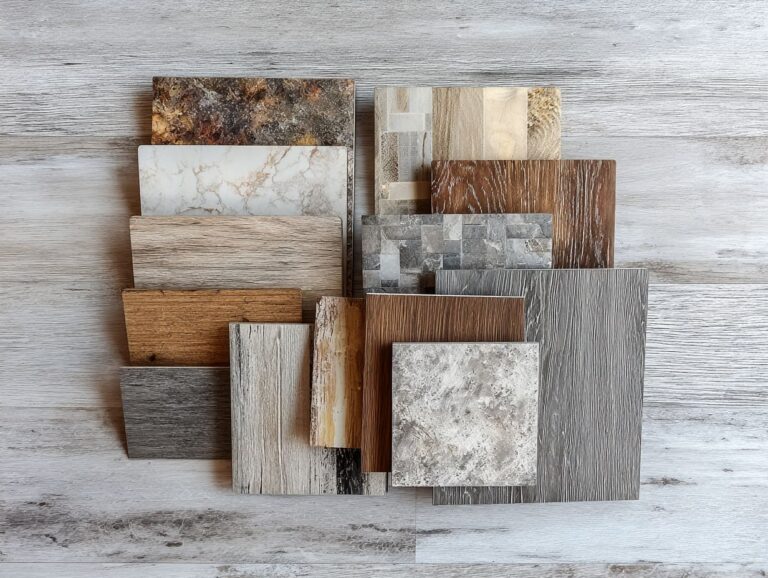Laminate Flooring Underlayment Types – Complete Guide
Choosing the best underlayment for your laminate flooring can significantly impact its performance and longevity. This guide looks at different types of underlayment, such as Foam Underlay and Cork Underlay, made for specific subfloor types. Learn how to improve comfort, reduce noise, and resist moisture, all while making sure it works with your flooring. Take a look at our thorough guide on underlay to help you choose wisely and improve your laminate flooring!
Key Takeaways:
Contents
- Laminate Flooring Market Statistics
- Types of Laminate Flooring Underlayment
- Comparative Analysis of Underlayment Types
- Choosing the Right Underlayment
- Installation Tips for Laminate Flooring Underlayment
- Common Mistakes to Avoid
- Frequently Asked Questions
- What are the different types of underlayment for laminate flooring?
- Do I need underlayment for my laminate flooring?
- Which underlayment is best for soundproofing?
- Can I install underlayment on top of existing flooring?
- How do I choose the right underlayment for my laminate flooring?
- Is underlayment necessary for laminate flooring over concrete?
What is Underlayment?

Underlayment is a thin layer of material installed beneath laminate flooring, serving as a critical buffer between the floor and the subfloor.
It plays several essential roles:
- First, it offers padding that makes it more comfortable and quiets the sound of people walking.
- Second, it offers moisture protection, preventing damage from potential water leaks, especially in areas like basements.
Common materials for underlayment include foam, cork, and rubber, each providing different levels of sound reduction and moisture resistance.
For example, cork underlayment absorbs sound and serves as a natural insulator, while foam is usually cheaper and simple to install. Choosing the right type depends on your specific flooring needs.
Importance of Underlayment in Laminate Flooring
Underlayment significantly impacts the longevity and comfort of laminate flooring, improving soundproofing and moisture resistance.
This layer makes the floor softer, creating a more inviting atmosphere in rooms like bedrooms and living rooms.
In kitchens, moisture-resistant underlayment protects against spills and humidity, preventing mold growth.
Reducing sound is important, and materials with Sound Transmission Class (STC) ratings of 50 or higher can effectively reduce noise transfer.
Picking the best underlayment, like foam for basic sound proofing or cork for extra thermal insulation, can greatly affect how your floors feel and how easy they are to keep up with, helping them last longer and work better. For those curious about the intricacies of laminate flooring production, you might appreciate our insights on High-Pressure vs Direct-Pressure Laminate Manufacturing.
Laminate Flooring Market Statistics
Laminate Flooring Market Statistics
When selecting laminate flooring, understanding the manufacturing process can influence your decision. Related insight: High-Pressure vs Direct-Pressure Laminate Manufacturing.
U.S. Laminate Flooring Market Trends 2023-2024: Sales Performance
U.S. Laminate Flooring Market Trends 2023-2024: Volume Decline
U.S. Laminate Flooring Market Trends 2023-2024: Sales by Channel
The Laminate Flooring Market Statistics provides a clear summary of U.S. laminate flooring market trends for 2023 and 2024, focusing on changes in sales outcomes, market distribution, and sales methods. These measurements give a full view of how the industry is changing with different economic and consumer trends.
Sales Performance data indicates a mild recovery in the market. While 2023 saw a 9.8% decrease in laminate flooring sales, the decline is expected to moderate to 7.5% in 2024. This suggests efforts to stabilize sales, possibly through strategic marketing or addressing supply chain challenges. Concurrently, the Volume Decline from 11.7% in 2023 to 4.8% in 2024 shows this recovery by concentrating on bringing back consumer interest and demand for laminate flooring products.
- Market Share Analysis: Despite a decrease, laminate flooring’s share in total flooring sales remains close to steady, with 4.8% in 2024 compared to 5.0% in 2023. This minor decline might reflect consumer preferences shifting towards other flooring types, yet the laminate sector retains a significant portion of the market. Similarly, the hard surface volume share slightly decreased from 9.9% in 2023 to 9.5% in 2024, indicating stable demand for hard flooring options, including laminates.
Sales by Channel reflects significant shifts in consumer buying patterns, with the specialty retail segment experiencing a notable increase in market share from 22.0% in 2023 to 30.0% in 2024. This rise implies a growing consumer preference for specialized stores offering extensive product knowledge and customer service. Conversely, warehouse clubs saw their share rise from 2.0% to 5.0%, hinting at increased consumer interest in bulk purchasing or cost-effective options. Consistent with maintaining its market position, Home Depot retains a steady 27.0% share, underscoring its role as a leading retailer in the sector.
Overall, the Laminate Flooring Market Statistics suggest a stabilizing market with a focus on strategic channel expansion and addressing consumer preferences. While the market faces challenges, there are clear opportunities for growth through targeted marketing, channel diversification, and consumer engagement strategies.
Types of Laminate Flooring Underlayment
There are different kinds of underlayment, each with specific advantages suited to particular flooring types and situations. As mentioned, understanding the construction and benefits of laminate flooring can help in choosing the right underlayment for your needs.
Foam Underlayment

Foam underlayment is a popular choice due to its affordability and effective sound insulation properties.
Foam underlayment usually costs between $0.30 to $0.80 per square foot. It provides an affordable way for homeowners to reduce noise.
Brands like FloorMuffler provide excellent performance, reducing impact noise by 20-25 decibels. Putting it in place is simple. Just unroll it on top of the base floor before you install the new flooring, making it easy for do-it-yourself projects.
This versatility makes foam underlayment ideal for various settings, from apartments to busy homes, ensuring peace and comfort without a hefty investment.
Felt Underlayment
Felt underlayment is popular because it uses environmentally friendly materials and reduces noise, making it a good option for homeowners.
Its moisture barrier properties protect flooring from humidity, particularly beneficial in basements or areas prone to water exposure.
Pricing ranges from $0.50 to $1.00 per square foot, offering affordability for various budgets.
Felt underlayment is compatible with different flooring types, including laminate, hardwood, and tile, enhancing insulation across the board.
For a dependable choice, look at products like Noise Guard. They cut down noise and improve heat insulation, making your rooms more cozy.
Rubber Underlayment
Rubber underlayment is great for reducing noise and handling impact, ideal for busy areas with frequent walking.
With prices ranging from $0.75 to $1.50 per square foot, rubber underlayment is a cost-effective solution for noise reduction, particularly beneficial in multi-story homes.
For example, using brands like Silent Step improves sound quality and offers thermal insulation. Put it down flat before you install your flooring.
This underlayment significantly minimizes footfall sounds and vibrations, creating a quieter living environment. Its strong construction guarantees it will last a long time, offering good value for homes or businesses.
Cork Underlayment
Cork underlayment is celebrated for its natural properties, providing excellent thermal insulation and noise absorption.
Cork underlayment offers extra advantages. This flooring option is good for the environment because it uses materials that can be replaced naturally.
This type of underlayment typically costs between $0.80 to $1.20 per square foot, which is competitive compared to alternatives like foam and rubber.
Notably, products like the ‘Cork Comfort’ underlayment offer superior compatibility with moisture barriers, ensuring your flooring remains protected in humid conditions.
With its blend of affordability, durability, and environmental consideration, cork underlayment proves to be an exceptional choice for homeowners.
Comparative Analysis of Underlayment Types
Reviewing different underlayment choices reveals key differences in their ability to lessen noise, manage moisture, and their cost, helping homeowners make informed decisions.
Sound Absorption Properties
Sound absorption varies significantly across underlayment types, impacting overall floor acoustics and comfort levels.
When comparing foam, cork, and rubber underlayment, each material exhibits different sound transmission class (STC) ratings.
Foam, typically offering STC ratings between 19-30, is excellent for reducing impact noise in residential spaces.
Cork has an STC rating of 20-34, meaning it absorbs sound and insulates as well.
Rubber underlayment is known for its STC ratings of 30-40, making it very helpful in environments such as offices or gyms.
Choosing the right underlayment depends on the specific noise control needs and the type of flooring installed.
Moisture Resistance
Moisture protection is important for keeping laminate floors intact, especially in places prone to wetness.
In basements, a moisture barrier is essential to prevent seepage and preserve flooring. Think about using polyethylene sheets or special underlayment like AquaStop, which resists wetness and reduces noise.
In contrast, dry rooms like bedrooms typically require less attention to moisture resistance, and a standard foam underlayment suffices. Incorporating a vapor barrier can still offer extra protection.
By knowing what each room needs, you can choose the best underlayment to make your laminate flooring last longer.
Insulation and Comfort
The insulation properties of underlayment contribute significantly to the comfort performance of laminate floors.
Different types of underlayment offer varying levels of thermal insulation.
Cork underlayment holds heat effectively and lowers sound, which makes it an excellent option for chilly places. Foam underlayment is an affordable choice that improves comfort and offers good insulation.
In a case study of a home in Minnesota, switching to cork underlayment reduced heating costs by 15% over winter months, significantly improving foot comfort.
To choose the right type, consider local climate, budget, and desired comfort levels.
Cost Considerations

Cost is a significant factor when selecting underlayment, with prices ranging widely based on material type and features.
Prices typically range from $0.50 to $2.00 per square foot for foam, cork, and rubber underlayments.
Foam is the most economical, suitable for areas with low foot traffic, while cork offers better sound insulation at a moderate price. Rubber underlayment is more expensive but durable and prevents moisture, making it suitable for high-traffic areas such as living rooms or basements.
Think about long-term expectations: spending more on better materials like rubber can lower the cost of replacements later, especially in areas where materials need to last.
Choosing the Right Underlayment
Choosing the correct underlayment means thinking about different aspects to get the best results and long-lasting use.
Factors to Consider
Key factors to consider include floor type, installation location, and specific performance needs like moisture resistance and soundproofing.
When selecting underlayment, look for these essential characteristics:
- Thickness-opt for at least 1/4 inch for better sound dampening;
- Material-foam is great for laminate, while cork offers superior sound and moisture control;
- A moisture barrier is especially important in basements or bathrooms.
For instance, a 6mm thick foam underlayment is perfect for most hardwood floors, while a cork underlayment with an integrated moisture barrier is ideal for tile in humid areas.
These choices can greatly improve the durability and comfort of the floor.
Compatibility with Flooring
Ensuring compatibility between the underlayment and flooring type is critical for achieving the best results.
For click-lock vinyl flooring, a foam underlayment is typically recommended for its sound-dampening properties and ease of installation. Products like Mohawk’s 3mm underlayment provide excellent cushioning and cost around $0.59 per square foot.
Alternatively, if you’re working with glue-down hardwood, a felt underlayment is more suitable as it offers moisture resistance and stability; consider Roberts Super Felt, which retails for about $0.75 per square foot.
When choosing, always look at the manufacturer’s instructions to make sure it will work properly and won’t affect the warranty.
Installation Requirements
Knowing what is needed to install underlayment is key for a successful laminate flooring project.
To install underlayment properly, start with the right preparation. Clean the floor surface of any debris and check that the subfloor is dry and even.
Tools you’ll need include:
- a utility knife for trimming,
- a tape measure for accuracy,
- and foam rollers for smooth application.
Common pitfalls include failing to acclimate the underlayment to room temperature and ignoring moisture barriers in high-humidity areas.
Each underlayment type has unique attributes; for instance, foam is cost-effective but less soundproof, while cork is eco-friendly and offers better insulation. Choose based on your specific needs for durability and comfort.
Installation Tips for Laminate Flooring Underlayment
Correctly installing the underlayment is essential for improving the performance and lifespan of laminate flooring.
Preparation of the Subfloor
Getting the subfloor ready is an important first step for the laminate flooring and underlayment to work correctly.
- Start by thoroughly cleaning the subfloor to remove any dust, debris, or old adhesive.
- Next, use a leveling compound to fill any low spots, which provides a smooth surface for the laminate.
- It’s essential to perform a moisture test; you can use a moisture meter to check levels-aim for less than 12% to prevent damage to the flooring.
- Before installation, allow any leveling compound to fully cure, usually 24 hours, ensuring the best foundation for your new flooring.
Proper Underlayment Installation Techniques
Adhering to proper installation techniques will significantly affect the effectiveness of the underlayment.
- Start by ensuring the subfloor is clean and dry, eliminating any debris that could compromise the underlayment.
- Use overlapping seams, with at least 8 inches of overlap to provide a moisture barrier. Apply tape specifically designed for underlayment to secure these seams and prevent water seepage.
- Make sure the underlayment is flat without any wrinkles or bubbles, so the floor finish will be smoother. It typically takes 2-4 hours for a standard room, depending on the size and condition of the subfloor.
Common Mistakes to Avoid
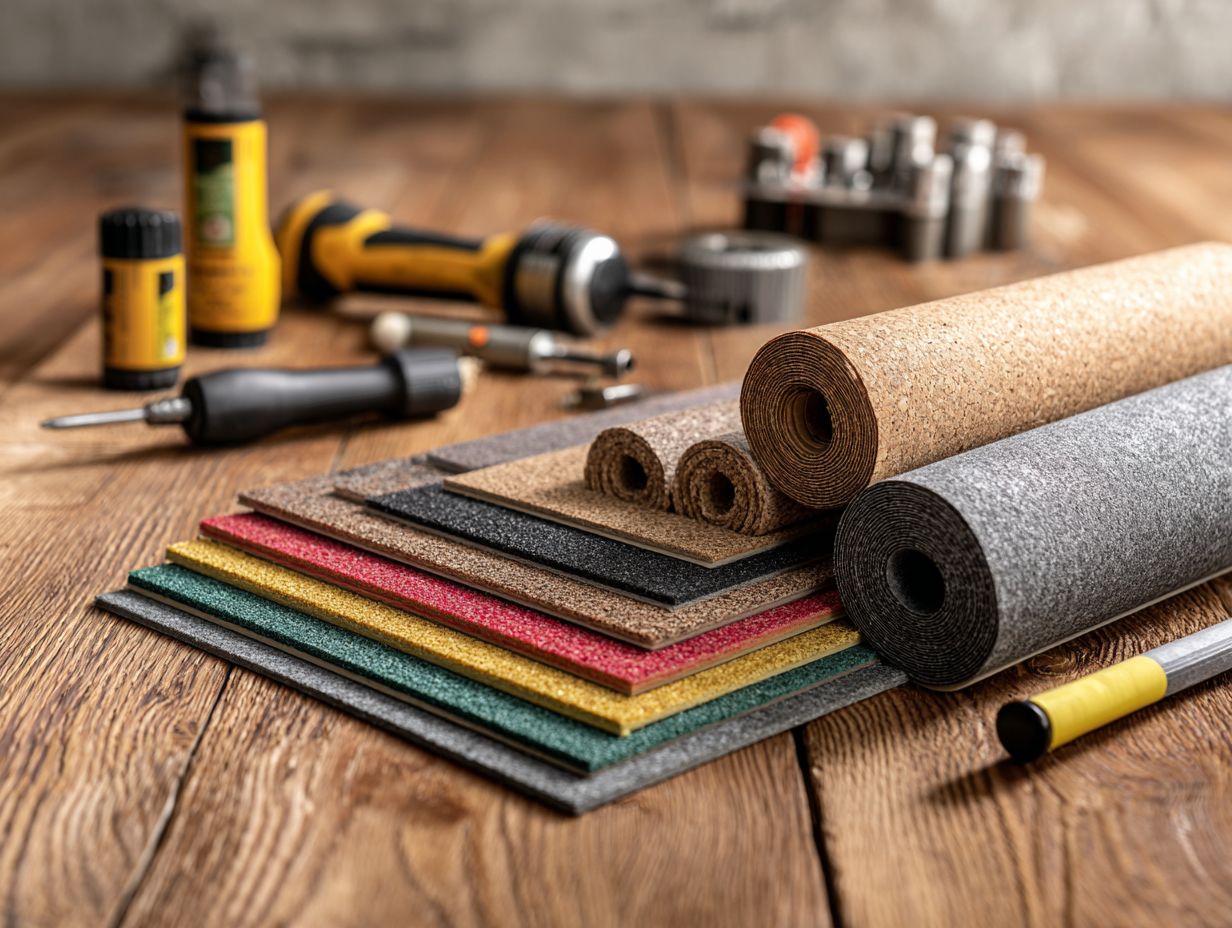
Choosing and installing underlayment correctly can save time and improve how well the flooring works.
Choosing the Wrong Type
Selecting the inappropriate type of underlayment can lead to significant issues such as increased noise or moisture damage.
For example, placing a thin foam layer under hardwood floors can lead to louder footstep noises. This problem can be avoided by choosing a cork or rubber underlayment, which offers better sound insulation.
Putting a moisture barrier under the floor in places like basements is very important; without it, mold can grow and wood can warp. Always assess your flooring type and location-whether it’s laminate, tile, or hardwood-to select the right underlayment that caters to both sound and moisture control.
Neglecting Moisture Barriers
Neglecting to install a moisture barrier can result in costly damage to both the flooring and the subfloor structure.
To properly set up a moisture barrier, start by selecting a strong polyethylene sheet, preferably 6 mil thick, for long-lasting performance.
Lay the sheet on the ground, overlapping seams by at least 12 inches and sealing them with waterproof tape. In areas like basements or kitchens, it’s critical to extend the barrier up the walls a few inches for added protection.
Failing to do this can lead to mold growth, wood rot, and serious structural issues, which are often significantly more expensive to repair than the upfront installation cost.
Final Thoughts on Underlayment Selection
Choosing the right underlayment involves considering comfort, cost, and specific flooring requirements to achieve the best outcome.
Start by assessing your flooring type-carpet, laminate, or hardwood-because each has unique underlayment needs.
For instance, a foam underlayment might work well with laminate for sound absorption and cushioning, while a vapor barrier underlayment is essential for hardwood in moisture-prone areas.
Consider tools like the Home Depot flooring calculator to estimate your underlayment costs based on room size.
Always check the manufacturer’s instructions to make sure all parts are compatible; this step helps your flooring last longer and function properly.
Frequently Asked Questions
What are the different types of underlayment for laminate flooring?
There are different kinds of underlayment for laminate flooring, such as foam, felt, cork, and rubber. Each type offers different levels of sound and moisture protection.
Do I need underlayment for my laminate flooring?
While it is not always necessary, underlayment can provide added benefits such as noise reduction, cushioning, and moisture protection. It is recommended to use underlayment for better installation and longevity of your laminate flooring.
Which underlayment is best for soundproofing?
If soundproofing is a top concern, consider using a rubber or cork underlayment. These materials are thicker and provide better sound insulation compared to foam or felt underlayment.
Can I install underlayment on top of existing flooring?
In most cases, it is not recommended to install underlayment on top of existing flooring. This can create an uneven surface and may cause issues with your laminate flooring installation.
How do I choose the right underlayment for my laminate flooring?
The best underlayment for your laminate flooring will depend on your specific needs and budget. Consider factors such as soundproofing, moisture protection, and overall durability when selecting the right underlayment for your project.
Is underlayment necessary for laminate flooring over concrete?
Yes, underlayment is highly recommended for laminate flooring over concrete to provide a moisture barrier and prevent any potential damage to your flooring. Foam or rubber underlayment are good options for concrete subfloors.
